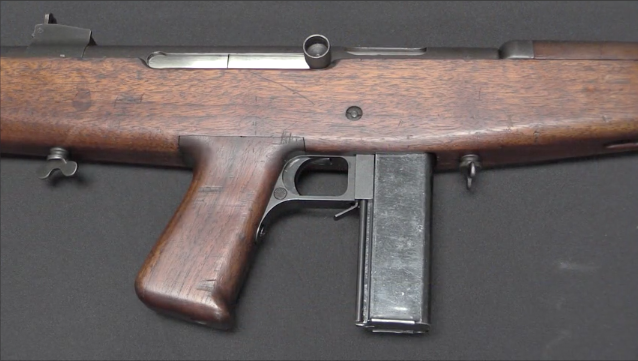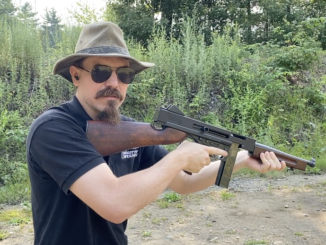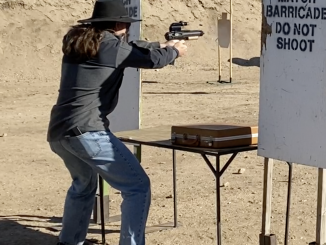Charles Manville developed this weapon in the 1930s as a riot control tool, and they were built in 12ga, 25mm, and 37mm. We should point out that the 12ga version was for tear gas rounds only (like today’s 12ga flare launchers) and not safe to use with high-pressure ammunition. Anyway, it was intended for use by prison guards and riot police, offering a much greater ammunition capacity than any other contemporary launcher.
We had the chance to take a closer look at one of the 25mm guns (not 26.5mm or 27mm as sometimes described):
While we were not able to take that one out for a test firing session, we did come across this video of someone else doing so. It looks to be a digitized VHS tape, and we take no responsibility for the “trained professional” pointing it right at his cameraman every time…but it does show a Manville in action:
During World War II, Manville tried to sell the military on a high-pressure version to fire 37mm explosive rounds, but was unsuccessful. Instead, the Manville company spent the was making parts for the Oerlikon 20mm AA guns, and the tooling for the gas launcher was all destroyed.




Why doesn’t the pressure in the chamber (blow back) overcome the thumbscrews and force the gun apart on firing? Do the cartridges grip the sides of the chamber well enough under pressure to hold them in the chamber without support? Are there grooves in the walls of the chamber, like on the PMM version of the Makarov? Or, is there some other mechanism which holds it together which isn’t visible to us?
The chamber pressure of these cartridges is much lower than that of a conventional firearm, thus allowing the use of thumbscrews in the design.
He might be a trained professional, but his suit is an old style sand blasting suite. LOL!
Also for the people to young to remember that bell ringing sound in the background is the “Ringer” a car would activate by running over a ground mounted wire to call a “Gas Jockey” to come a pump some gas back when a service stations had employees pump the gas.
Anyone here old enough to recall a 1981 movie ‘Dogs of War’ (Forsyth’s novel adaptation) with Christopher Walken flying Convair 440, and then blasting Valmet 76-wielding bad guys to smithereens with a Manville MM1 ostensibly firing HE? Not to mention Uzis, half of which tended to be Steyr MPi 69s and the other half MAC10s?
Yes Leszek, guilty as charged. Tried to explain to frinds about the Manvilles( saw Them in Swerigan’s “Combat Shotguns..” and got fobed of with” Just peops they made up”
Leszek, I not only clearly recall the movie version of “The Dogs Of War”, I also read the original Frederick Forsyth novel well before that! I was very much already an adult well into military service in 1981, so I certainly agree with your observations on the weaponry involved, having actually handled and/or used the ones in question, among others, with varying results.
That’s really awesome, I want one
Too bad the Manville 37mm high explosive cartridge wasn’t mated with 1930’s 37mm single shot gas guns and issued to US troops in 1942–give the grenadier a carbine and a 37mm grenade launcher with two dozen rounds and it would have been quite the bunker buster.
Remember the panic over the Streetsweeper revolver shotgun? Eventually, such guns were designated “destructive devices” and “regulated” (banned)–forcing street gangs to increase firepower by using single shot weapons that could be loaded and fired at a higher rate (more shotgun shells per minute). Disassembling the Manville and punching out the empties and then poking fresh gas shells in one at a time before reassembly and then winding up the gun can take a while.
For extreme shotgun firepower relative to the Manville and at a far cheaper price, go with a pump shotgun. Five, six, seven or more gas shells fired as rapidly as the shotgunner can press the trigger and cycle the action. I’m slow but I managed five shots in under three seconds with 100% hits on 8-inch steel plates at 10 yards with a Remington 870.
Which is why the expensive Manville didn’t catch on. A purpose-built gun that could only launch gas versus the cheaper standard shotgun–and if you needed to saturate an area with 12 gauge gas projectiles in a hurry, either use an extended magazine tube of ten rounds or have two or three gas officers firing at the same time. The 12 gauge gas grenade doesn’t have much payload but was favored over the 37mm (still is) due to being usable in standard shotguns–
–which brings up the issue of mixing buckshot and “less lethal munitions.” The barricade penetration round below can be lethal:
http://www.nonlethaltechnologies.com/12-BP.htm
Can’t win them all.
I’ve left link to rare 1937 video of Manville Gas Gun down below the other article some days ago. Looks not enough…
So here https://youtu.be/zp_V-9sXJkA please, enjoy.